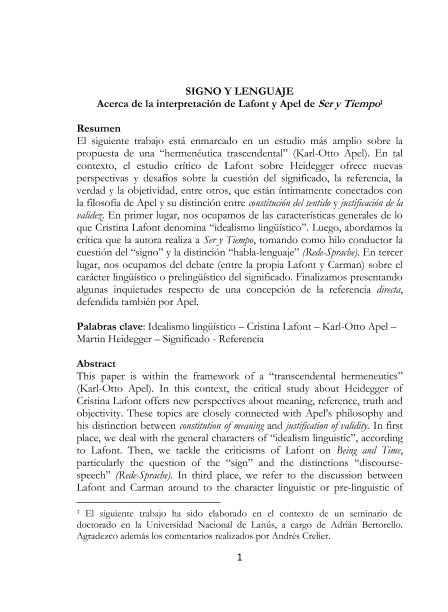Artículo
Este trabajo forma parte de un estudio más amplio sobre la "hermenéutica trascendental" de Apel. En tal contexto, el estudio crítico de Lafont sobre Heidegger ofrece nuevas perspectivas sobre la cuestión del significado, la referencia, la verdad y la objetividad que están íntimamente conectados con la filosofía de Apel y su distinción entre constitución del sentido y justificación de la validez. En primer lugar, nos ocupamos de lo que Lafont denomina "idealismo lingüístico". Luego, abordamos la crítica que la autora realiza a Ser y Tiempo, tomando como hilo conductor la cuestión del "signo" y la distinción "habla-lenguaje" (Rede-Sprache). En tercer lugar, tratamos el debate (entre la propia Lafont y Carman) sobre el carácter lingüístico o prelingüístico del significado. Finalizamos presentando algunas inquietudes respecto de una concepción de la referencia directa, defendida también por Apel. This paper is part of a wider study about Apel's "transcendental hermeneutics". In that context, Cristina Lafont's critical approach to Heidegger offers new perspectives about meaning, reference, truth and objectivity. These topics are closely connected with Apel's philosophy and his distinction between constitution of meaning and justification of validity. First, we deal with what Lafont calls "linguistic idealism". Second, we treat Lafont's criticism of Being and Time, particularly the question of the "sign" and the distinction "discourse-speech" (Rede-Sprache). In third place, we analyze the debate between Lafont and Carman about the linguistic or pre-linguistic character of meaning. We conclude with some questions relative to a particular conception of direct reference, which is defended by Apel too.
Signo y lenguaje: Acerca de la interpretación de Apel y Lafont de ser y tiempo
Fecha de publicación:
12/2011
Editorial:
Asociación Revista de Filosofía de Santa Fe
Revista:
Tópicos
ISSN:
1668-723X
Idioma:
Español
Tipo de recurso:
Artículo publicado
Clasificación temática:
Resumen
Palabras clave:
Karl-Otto Apel
,
Hermenéutica
,
Filosofía del Lenguaje
Archivos asociados
Licencia
Identificadores
Colecciones
Articulos(INCIHUSA)
Articulos de INST. DE CS. HUMANAS, SOC. Y AMBIENTALES
Articulos de INST. DE CS. HUMANAS, SOC. Y AMBIENTALES
Citación
Scivoletto, Gonzalo Martín; Signo y lenguaje: Acerca de la interpretación de Apel y Lafont de ser y tiempo; Asociación Revista de Filosofía de Santa Fe; Tópicos; 22; 12-2011; 231-248
Compartir
Altmétricas




